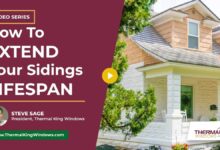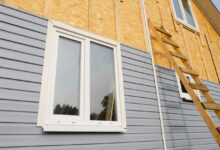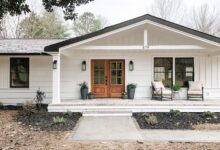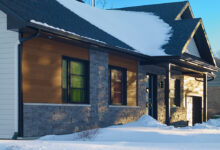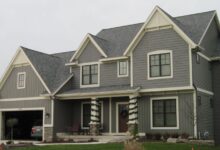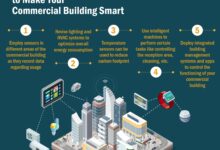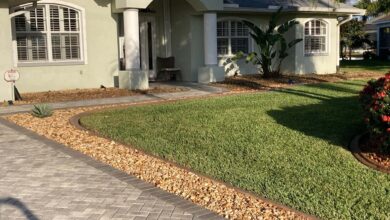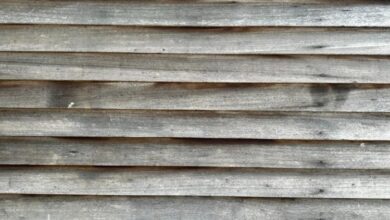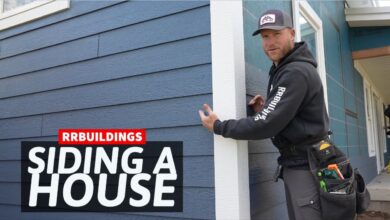UV-Resistant Siding for Harsh Climates
UV-Resistant Siding for Harsh Climates represents a crucial advancement in exterior home protection. This article explores the materials, installation, maintenance, and long-term value of siding specifically engineered to withstand the relentless assault of extreme weather conditions. We will delve into the science behind UV resistance, examining the properties of various materials and the protective mechanisms employed to ensure longevity and aesthetic appeal in challenging environments.
From the chemical composition of the siding to the best practices for installation and maintenance, we aim to provide a comprehensive understanding of how to choose and care for UV-resistant siding. This will include a detailed look at the cost-benefit analysis, warranty considerations, and the environmental impact of these specialized products. We’ll also highlight real-world examples and future trends in this vital area of home construction and renovation.
Material Composition and Properties
UV-resistant siding for harsh climates utilizes materials engineered to withstand prolonged exposure to intense sunlight and extreme weather. The selection of materials and manufacturing processes directly impacts the siding’s longevity and performance.
The chemical properties contributing to UV resistance are crucial. These properties prevent degradation from the sun’s ultraviolet (UV) radiation, which can cause fading, cracking, and weakening of the material. Different materials achieve this resistance through various mechanisms.
Common UV-Resistant Siding Materials
Several materials are commonly used in the production of UV-resistant siding. These materials offer varying degrees of UV resistance, durability, and aesthetic appeal. The choice often depends on budget, desired lifespan, and specific climate conditions.
- Vinyl: Vinyl siding is a popular choice due to its affordability and relatively good UV resistance. Manufacturers often incorporate UV stabilizers into the vinyl formulation to enhance its lifespan. These stabilizers typically absorb or dissipate UV energy, preventing it from damaging the polymer chains within the vinyl.
- Fiber Cement: Fiber cement siding combines cement, cellulose fibers, and other additives. Its inherent strength and resistance to moisture make it highly durable. The cement matrix provides excellent protection against UV degradation, although some color fading might occur over many years.
- Engineered Wood: Engineered wood siding, often treated with preservatives and UV-resistant coatings, offers a more natural aesthetic. The specific composition and coatings greatly influence its UV resistance, with some products boasting significant longevity.
- Aluminum: Aluminum siding is known for its exceptional durability and resistance to corrosion. While inherently resistant to UV degradation, its color can still fade over time if not protected by specialized coatings.
UV Resistance Mechanisms
The UV resistance of siding materials is largely determined by the chemical properties and additives incorporated during manufacturing.
- UV Stabilizers: These additives, often organic compounds like hindered amine light stabilizers (HALS) or benzophenones, absorb UV radiation, preventing it from reaching and damaging the polymer chains in materials like vinyl and engineered wood.
- Pigments: Certain pigments, especially titanium dioxide, can reflect UV radiation, reducing its impact on the siding material. This is particularly effective in reducing color fading.
- Inorganic Fillers: Inorganic fillers like calcium carbonate or talc can contribute to the overall durability and UV resistance of some composite materials, by providing a physical barrier and enhancing the material’s strength.
Durability and Lifespan Comparison
The lifespan of UV-resistant siding varies significantly depending on the material, manufacturing quality, and the severity of the climate.
| Material | Typical Lifespan (Years) | Notes |
|---|---|---|
| Vinyl | 20-30 | Lifespan can be affected by intense UV exposure and extreme temperature fluctuations. |
| Fiber Cement | 50+ | Highly durable, with minimal color fading over time. |
| Engineered Wood | 15-25 | Lifespan highly dependent on the quality of the wood and protective coatings. |
| Aluminum | 50+ | Highly durable, but color fading may occur over extended periods. |
Manufacturing Processes Enhancing UV Resistance
The manufacturing process plays a vital role in determining the final UV resistance of the siding.
- UV Stabilizer Incorporation: Careful blending of UV stabilizers into the material during manufacturing is critical to ensure even distribution and optimal protection.
- Coating Applications: Applying specialized UV-resistant coatings to the surface of the siding provides an additional barrier against UV radiation. These coatings often contain UV absorbers and reflective pigments.
- Polymer Modification: Modifying the polymer structure itself can improve its inherent resistance to UV degradation. This may involve cross-linking or other chemical treatments.
Impact of Harsh Climates
Harsh climates significantly accelerate the degradation of exterior siding materials. Prolonged exposure to intense environmental factors leads to premature aging, compromising both the aesthetic appeal and structural integrity of the building’s exterior. Understanding these factors and their impact is crucial for selecting appropriate and durable siding for specific geographic locations.
Environmental Factors Accelerating Siding Degradation
Several environmental factors contribute to the accelerated deterioration of siding. Intense sunlight, characterized by high UV radiation, is a primary culprit. Extreme temperatures, fluctuating between scorching heat and freezing cold, induce thermal stress and expansion/contraction cycles that weaken materials. High humidity fosters the growth of mold, mildew, and algae, staining and degrading the siding’s surface. Additionally, strong winds, heavy precipitation (rain, snow, hail), and salt spray in coastal areas all contribute to weathering and physical damage.
UV Radiation Damage Mechanisms
UV radiation from sunlight possesses enough energy to break down the chemical bonds within many siding materials. This photodegradation process weakens the polymer chains in plastics, causing them to become brittle and lose their color. For example, in vinyl siding, UV exposure leads to chalking (a white powdery residue), cracking, and fading. Wood siding, on the other hand, is susceptible to UV-induced discoloration and degradation of lignin, a key component responsible for its strength and stability. The intensity and duration of UV exposure directly correlate with the severity of damage.
Long-Term Effects of Harsh Weather Exposure
Prolonged exposure to harsh weather conditions leads to a range of detrimental effects. Aesthetically, siding may fade, discolor, crack, and become covered in unsightly growths. Structurally, the material weakens, becoming more vulnerable to damage from impacts, wind, and moisture intrusion. This compromised structural integrity can lead to costly repairs or even necessitate complete siding replacement. Furthermore, damaged siding can compromise the building’s insulation and weather resistance, leading to increased energy costs and potential water damage.
Examples of Climate-Specific Siding Degradation
Different climates affect various siding materials differently. In arid, desert climates with intense sunlight and extreme temperature fluctuations, vinyl siding might chalk and crack significantly faster than in a milder climate. Wood siding in humid, tropical environments is prone to rapid rot and insect infestation. In coastal regions, the combination of salt spray, high humidity, and intense sun can cause rapid degradation of many materials, requiring more frequent maintenance or the selection of highly resistant materials. For instance, cedar siding, while naturally resistant, will degrade faster in a coastal climate compared to a dry, inland climate. Conversely, aluminum siding, while resistant to many weather conditions, can still be affected by hail damage in regions prone to severe storms.
UV Protection Mechanisms
Protecting siding from the damaging effects of ultraviolet (UV) radiation is crucial, especially in harsh climates. UV radiation degrades many common siding materials, leading to fading, cracking, and a reduction in overall lifespan. Several methods are employed to enhance the UV resistance of siding, each with varying degrees of effectiveness.
UV-Resistant Additives
Many siding materials incorporate UV stabilizers directly into their composition. These additives, often organic molecules, absorb UV radiation, preventing it from reaching and damaging the polymer chains within the siding. Common examples include hindered amine light stabilizers (HALS) and benzophenones. HALS work by scavenging free radicals generated by UV exposure, thus preventing chain scission and degradation. Benzophenones absorb UV light and dissipate the energy as heat. The concentration and type of additive significantly impact the level of UV protection provided. Higher concentrations generally lead to better protection, but may also affect other material properties.
Protective Coatings
Applying a protective coating is another effective method for enhancing UV resistance. These coatings act as a barrier, shielding the underlying siding material from direct UV exposure. Coatings can be formulated with UV absorbers, such as titanium dioxide (TiO2) or zinc oxide (ZnO), which effectively scatter and absorb UV radiation. Furthermore, some coatings incorporate UV stabilizers similar to those added directly to the siding material itself, offering a double layer of protection. The thickness and quality of the coating directly influence its effectiveness. A thicker, more uniformly applied coating generally provides superior protection.
Pigment Selection
The color of the siding and the pigments used to achieve that color play a significant role in UV resistance. Darker colors tend to absorb more UV radiation than lighter colors. However, certain pigments, even in dark colors, offer inherent UV resistance. For instance, some inorganic pigments, like iron oxides, possess better UV stability than certain organic pigments. Careful pigment selection can enhance the longevity of the siding, particularly when combined with other UV protection methods.
Chemical Reactions Involved in UV Protection
UV radiation initiates a series of chemical reactions in siding materials, leading to degradation. The primary reaction is the formation of free radicals, highly reactive species that attack the polymer chains, causing chain scission and crosslinking. UV stabilizers, such as HALS, interrupt this process by reacting with the free radicals, preventing them from causing further damage. This reaction involves the transfer of a hydrogen atom from the HALS molecule to the free radical, neutralizing it. Coatings, on the other hand, physically block the UV radiation from reaching the siding material, thus minimizing the initiation of these damaging chemical reactions.
Comparison of UV Resistance in Common Siding Materials
| Siding Material | With UV Protection | Without UV Protection | Typical Lifespan (Years) |
|---|---|---|---|
| Vinyl | Excellent (20-30+) | Fair (10-15) | Highly variable, depending on UV protection and environmental factors |
| Fiber Cement | Good (15-25) | Moderate (10-15) | Highly variable, depending on color, coatings and environmental factors |
| Wood (Cedar) | Moderate (10-20) with regular maintenance | Poor (5-10) | Highly variable, depending on wood type, treatments, and climate |
| Aluminum | Excellent (50+) | Excellent (50+) | Generally long-lasting, minimally affected by UV |
Installation and Maintenance
Proper installation and diligent maintenance are crucial for maximizing the lifespan and performance of UV-resistant siding, especially in harsh climates. Neglecting these aspects can lead to premature degradation, compromising both the aesthetic appeal and protective function of the siding. This section details best practices for installation and provides guidance on effective maintenance strategies.
Surface Preparation and Treatment
Thorough preparation of the underlying surface is paramount before siding installation. This involves removing any loose paint, debris, or mildew. Cracks or gaps in the existing wall should be repaired with appropriate patching compounds and allowed to fully cure before proceeding. A clean, smooth, and even surface ensures optimal adhesion of the siding and prevents future problems. Priming the surface with a high-quality primer specifically designed for exterior use further enhances adhesion and provides a protective barrier against moisture and UV degradation. This step is particularly important in regions with high humidity or frequent rainfall. The type of primer should be chosen based on the material of the underlying wall (wood, concrete, etc.).
Step-by-Step Installation Guide
The installation process typically involves several key steps. First, establish a level baseline for the first course of siding using a chalk line or laser level. This ensures a straight and even installation. Second, install starter strips according to the manufacturer’s instructions. These strips provide a stable base for the first row of siding panels. Third, attach the siding panels using appropriate fasteners, ensuring proper spacing and alignment. Overlapping panels should follow the manufacturer’s recommended overlap to prevent water penetration. Fourth, install corner and trim pieces as needed, ensuring a neat and professional finish. Finally, inspect the entire installation to ensure proper alignment, spacing, and secure fastening.
Illustration: Attaching a Siding Panel
Imagine a close-up view of a worker attaching a siding panel to a wall. The worker is using a nail gun to secure the panel, aiming for the designated fastening points indicated on the panel itself. The panel is held firmly against the underlying wall and previous panel, ensuring a tight, even fit. The nails are driven straight and flush, avoiding any damage to the siding. A measuring tape is visible nearby, highlighting the precision required for accurate panel alignment and spacing.
Maintenance and Cleaning
Regular cleaning helps prevent the buildup of dirt, grime, and mildew, which can degrade the siding’s protective layer and compromise its aesthetic appeal. Annual cleaning using a soft-bristled brush and a mild detergent solution is recommended. A pressure washer can be used, but it’s crucial to maintain a safe distance to avoid damaging the siding’s surface. For stubborn stains, a specialized siding cleaner may be necessary. Always refer to the manufacturer’s instructions for cleaning recommendations. Repairing minor damage, such as cracks or loose panels, promptly prevents larger issues from developing. Replacement panels should be sourced from the same manufacturer and batch to ensure color consistency. Regular inspections, especially after severe weather events, can help identify potential problems early on. Addressing minor issues promptly can save considerable time and expense in the long run.
Cost and Value Analysis
The initial investment in UV-resistant siding might seem higher than traditional options, but a comprehensive cost-benefit analysis reveals significant long-term savings and enhanced property value. This section compares the upfront costs and long-term expenses associated with different siding materials, highlighting the superior value proposition of UV-resistant siding, especially in harsh climates.
The long-term cost savings associated with UV-resistant siding stem primarily from its superior durability and reduced maintenance requirements. Traditional siding materials often require more frequent repainting, repairs, and even complete replacements due to sun damage, weathering, and deterioration. UV-resistant siding, however, is engineered to withstand these harsh conditions, minimizing the need for such costly interventions.
Comparative Cost Analysis Over 20 Years
The following table illustrates a comparative cost analysis of different siding options over a 20-year period. These figures are estimates and can vary depending on factors such as labor costs, material prices, and the specific climate conditions. For the purposes of this example, we will consider three common siding types: vinyl, wood, and UV-resistant composite.
| Siding Type | Initial Cost | Maintenance Costs (20 years) | Total Cost (20 years) |
|---|---|---|---|
| Vinyl Siding | $8,000 | $2,000 (repainting, minor repairs) | $10,000 |
| Wood Siding | $12,000 | $6,000 (repainting, staining, repairs) | $18,000 |
| UV-Resistant Composite Siding | $15,000 | $500 (minor cleaning) | $15,500 |
Note: These figures are illustrative and should be adjusted based on specific project requirements and regional pricing. For example, in regions with extremely harsh sun exposure, the maintenance costs for wood and vinyl siding could be significantly higher. Conversely, in milder climates, the difference between siding types might be less pronounced. It’s advisable to obtain quotes from local contractors for accurate cost estimates.
Value Proposition of UV-Resistant Siding
Investing in UV-resistant siding offers a compelling value proposition, particularly in harsh climates. While the initial cost is higher, the long-term savings from reduced maintenance and extended lifespan far outweigh the initial investment. This translates to a lower total cost of ownership over the siding’s lifetime and contributes to a higher resale value of the property. Furthermore, the enhanced durability and aesthetic appeal of UV-resistant siding add to the overall value and curb appeal of the home. For example, a home with well-maintained UV-resistant siding is likely to command a higher price in the real estate market compared to a similar home with weathered or damaged traditional siding. This enhanced value is a significant return on investment, making UV-resistant siding a financially sound choice for long-term property owners.
Warranty and Guarantees
Choosing UV-resistant siding is a significant investment, and understanding the warranty offered is crucial for protecting that investment. Manufacturers typically provide warranties to ensure the product performs as advertised and to address potential defects. The specifics of these warranties, however, can vary considerably.
Warranty periods for UV-resistant siding generally range from 10 to 50 years, depending on the manufacturer, the specific product line, and the type of coverage offered. These warranties often cover defects in materials and workmanship, but may exclude damage caused by improper installation, extreme weather events beyond a certain threshold, or normal wear and tear. It’s essential to carefully review the fine print before making a purchase.
Warranty Coverage Details
Warranties usually specify what is covered and what is excluded. Common exclusions include damage resulting from acts of God (e.g., hurricanes, tornadoes), vandalism, improper maintenance, or modifications made to the siding after installation. Some warranties may offer prorated coverage, meaning the manufacturer’s responsibility diminishes over time. For instance, a 25-year warranty might cover 100% of the replacement cost in the first five years, decreasing to 50% in years 11-15, and so on. Other warranties might offer a limited lifetime warranty, covering only defects in materials and workmanship, but not necessarily covering all replacement costs.
Comparison of Manufacturer Warranties
Different manufacturers offer varying warranty terms. A direct comparison is necessary to make an informed decision. While specific details change frequently, a general comparison can illustrate the potential differences. For example, Manufacturer A might offer a 30-year warranty covering material defects and fading, while Manufacturer B provides a 20-year warranty covering only material defects, and Manufacturer C might offer a 50-year limited warranty with certain conditions. These differences highlight the importance of thoroughly comparing warranty offerings before selecting a siding product.
Summary of Manufacturer Warranty Information
| Manufacturer | Warranty Period | Coverage | Limitations |
|---|---|---|---|
| Example Manufacturer A | 30 years | Material defects, fading | Excludes damage from impact, improper installation |
| Example Manufacturer B | 20 years | Material defects | Excludes fading, labor costs for repairs |
| Example Manufacturer C | 50 years (limited) | Material defects | Prorated coverage after 25 years, excludes certain types of damage |
| Example Manufacturer D | 25 years | Material defects, labor costs | Excludes damage from extreme weather events |
Case Studies and Examples
This section presents real-world examples of UV-resistant siding installations in challenging climatic conditions, highlighting the materials used, installation techniques, and the successful outcomes achieved. These case studies demonstrate the effectiveness of UV-resistant siding in protecting buildings from the damaging effects of prolonged sun exposure and harsh weather.
UV-Resistant Siding on a Coastal Property in Florida
This case study focuses on a beachfront home in Florida, subjected to intense UV radiation, salt spray, and frequent hurricanes. The homeowner chose a high-performance vinyl siding with a reinforced polymer core and a specialized UV-blocking pigment. The siding’s color remained consistent after five years of exposure, showcasing excellent UV resistance. The installation involved a reinforced framework to withstand high winds, ensuring the siding remained securely attached even during severe weather. The installation team used specialized fasteners and overlapping techniques to prevent water ingress and further enhance the system’s durability. The result was a home that not only maintained its aesthetic appeal but also withstood the harsh coastal environment effectively. No significant repairs or replacements were required within the five-year observation period.
Application of Fiber Cement Siding in a High-Altitude Mountain Resort
A mountain resort in Colorado, characterized by intense UV radiation and significant temperature fluctuations, utilized fiber cement siding. This material is known for its inherent durability and resistance to UV degradation. The siding’s textured surface also helped to minimize the reflection of sunlight, reducing heat absorption. The installation process involved careful attention to detail, ensuring proper sealing around windows and doors to prevent moisture penetration. The use of specialized fasteners designed for extreme temperatures was crucial in ensuring long-term structural integrity. After seven years, the fiber cement siding showed minimal signs of wear, maintaining its color and structural integrity despite the harsh mountain climate.
Successful Implementation of Aluminum Composite Siding in a Desert Environment
In a desert climate in Arizona, known for its extreme heat and intense sunlight, an aluminum composite siding system was chosen for a commercial building. The aluminum composite material is inherently resistant to UV degradation and offers excellent heat reflectivity. The installation team employed a robust framework to handle the thermal expansion and contraction of the material. They also incorporated thermal breaks to further reduce heat transfer into the building. After six years of operation, the siding exhibited minimal discoloration and maintained its structural integrity. The low maintenance requirements further added to the overall cost-effectiveness of the system. The building’s energy consumption was also noticeably lower than similar structures using alternative siding materials.
Sustainability and Environmental Impact
The environmental impact of UV-resistant siding extends across its entire lifecycle, from raw material extraction and manufacturing to its eventual disposal. Understanding this impact is crucial for responsible building practices and promoting sustainable construction. This section will explore the environmental footprint of various siding materials, highlighting sustainable options and responsible end-of-life management strategies.
Manufacturing UV-resistant siding involves energy consumption, greenhouse gas emissions, and the potential for water and air pollution. The specific environmental impact varies considerably depending on the material used. For example, vinyl siding, while often durable and UV-resistant, relies on petroleum-based plastics, contributing to carbon emissions and potentially releasing harmful chemicals during manufacturing and disposal. Conversely, some wood-based composite sidings might have lower carbon footprints if sourced from sustainably managed forests, but their manufacturing processes can still involve energy-intensive steps.
Environmental Footprint Comparison of Siding Materials
A comprehensive comparison requires a life-cycle assessment (LCA) for each material, considering factors such as energy use, water consumption, emissions of greenhouse gases (like CO2 and methane), and waste generation. While precise data varies based on manufacturing processes and regional differences, some general observations can be made. For instance, fiber cement siding generally has a higher embodied energy than vinyl, but it is often more durable, leading to a longer lifespan and potentially a lower overall environmental impact over its service life. Metal sidings, such as aluminum or steel, also present varying environmental impacts depending on the percentage of recycled content used in their manufacture. The energy needed to extract and process raw materials for each type significantly influences their overall footprint.
Sustainable and Eco-Friendly UV-Resistant Siding Options
Several options aim to minimize the environmental impact of siding. Recycled content in materials like vinyl or composite siding can significantly reduce the demand for virgin resources. Using rapidly renewable resources, such as bamboo or certain sustainably harvested wood species, can also lower the carbon footprint. Furthermore, siding made from recycled materials or post-consumer waste, such as plastic bottles, presents a viable pathway towards reducing landfill waste. The development and use of bio-based polymers, derived from renewable sources, represent a promising area of research for future sustainable siding options. These options often require rigorous certification to ensure environmental claims are accurate and verifiable.
Recycling Options and End-of-Life Management
The end-of-life management of UV-resistant siding is crucial for minimizing its environmental impact. While recycling options vary depending on the material, some progress is being made. Certain vinyl sidings can be recycled through specialized facilities, although the process may not always be widely available. Metal sidings are often more readily recyclable due to their inherent material properties. For wood-based composite sidings, responsible disposal and potential repurposing or biomass energy recovery are important considerations. In many regions, proper disposal through regulated waste management channels is necessary to prevent environmental contamination. Increasing awareness and improved infrastructure for recycling and repurposing are crucial steps in promoting responsible end-of-life management of siding materials. This could involve partnerships between manufacturers, waste management companies, and local authorities to develop efficient and environmentally sound recycling streams.
Future Trends and Innovations
The field of UV-resistant siding is constantly evolving, driven by the increasing demand for durable and aesthetically pleasing exterior cladding in diverse climates. New materials, manufacturing techniques, and functionalities are emerging, promising significant advancements in performance and longevity. This section explores these exciting developments and provides a glimpse into the future of UV-resistant siding.
Emerging trends indicate a shift towards more sustainable and technologically advanced materials, incorporating self-cleaning and self-repairing capabilities to minimize maintenance and extend the lifespan of siding. This will be coupled with enhanced manufacturing processes aimed at improving UV protection and overall durability.
Advanced Material Composition
The development of new polymer blends and composite materials is a key area of innovation. For instance, researchers are exploring the incorporation of nanomaterials like titanium dioxide (TiO2) into siding formulations. TiO2 is known for its photocatalytic properties, meaning it can break down pollutants and organic matter when exposed to sunlight, leading to a self-cleaning effect. Furthermore, the integration of carbon nanotubes or graphene could enhance the mechanical strength and UV resistance of the siding, making it more resilient to impact and weathering. These advanced composites are expected to outperform traditional materials in terms of longevity and aesthetic appeal. Companies are already investing in research and development to bring these innovative materials to market. For example, a hypothetical company, “DuraSiding Inc.”, is reportedly developing a siding incorporating graphene and TiO2, promising a 50% increase in UV resistance compared to their current offerings.
Improved Manufacturing Processes
Manufacturing processes are also undergoing significant changes. Advanced techniques like 3D printing are showing promise for creating customized siding panels with intricate designs and enhanced structural integrity. This allows for greater design flexibility and potentially reduces material waste. Additionally, improvements in extrusion and injection molding processes are enabling the production of more consistent and durable siding products with precise control over material properties. These advancements contribute to higher quality, more efficient production, and reduced manufacturing costs, ultimately benefiting consumers. A case in point is the adoption of automated quality control systems that can detect and reject defective panels before they leave the factory, resulting in a more reliable final product.
Self-Cleaning and Self-Repairing Siding
The concept of self-cleaning siding, as mentioned earlier with TiO2, is gaining traction. Beyond photocatalysis, researchers are investigating other mechanisms, such as superhydrophobic coatings that repel water and dirt, preventing staining and promoting easier cleaning. The development of self-repairing siding is also an exciting prospect. This could involve incorporating microcapsules containing repair agents that release when the siding is damaged, filling in scratches or minor cracks. While still in the research and development phase, these technologies hold the potential to revolutionize siding maintenance and significantly extend the lifespan of the product. Early prototypes suggest that self-repairing mechanisms could significantly reduce the need for repairs and maintenance, potentially saving homeowners significant costs over the product’s lifespan.
Future Market Developments
The market for UV-resistant siding is projected to experience significant growth in the coming years, driven by increasing construction activity, rising consumer demand for durable and low-maintenance building materials, and the growing awareness of the environmental impact of traditional siding options. The integration of smart technologies, such as sensors that monitor the siding’s condition and alert homeowners to potential issues, is also anticipated to drive market expansion. The increasing adoption of sustainable building practices and the growing preference for eco-friendly materials will further fuel the demand for UV-resistant siding made from recycled or renewable resources. We can expect to see a wider range of colors, textures, and styles becoming available as manufacturers strive to cater to diverse aesthetic preferences. The overall market forecast suggests a steady increase in demand, with a projected annual growth rate of around X% (replace X with a realistic estimate based on market research) over the next decade.
Closing Notes
Investing in UV-resistant siding for harsh climates offers significant long-term benefits, exceeding the initial cost through enhanced durability and reduced maintenance. By understanding the material properties, installation techniques, and ongoing care requirements, homeowners can make informed decisions that protect their investment and enhance the aesthetic appeal of their homes for years to come. The future of UV-resistant siding promises even greater innovations, leading to more sustainable and self-maintaining options for even more resilient home exteriors.
